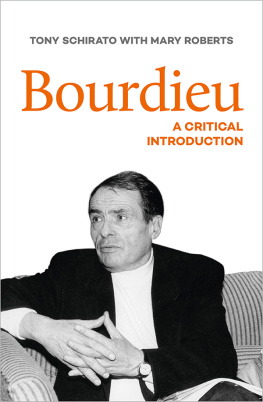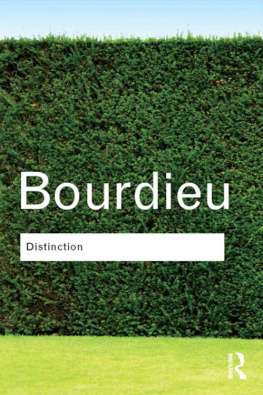Published in 2016 by
Berghahn Books
www.berghahnbooks.com
2016 Guy Austin
All rights reserved. Except for the quotation of short passages for the purposes of criticism and review, no part of this book may be reproduced in any form or by any means, electronic or mechanical, including photocopying, recording, or any information storage and retrieval system now known or to be invented, without written permission of the publisher.
Library of Congress Cataloging-in-Publication Data
Names: Austin, Guy, editor.
Title: New uses of Bourdieu in film and media studies / edited by Guy Austin.
Description: New York: Berghahn Books, 2016. | Based on a symposium held at Newcastle Universitys Research Centre in Film and Digital Media in late 2012. | Includes bibliographical references and index.
Identifiers: LCCN 2015046388| ISBN 9781785331671 (hardback: alk. paper) |
ISBN 9781785331688 (ebook)
Subjects: LCSH: Motion picturesCongresses. | Mass mediaCongresses. | Bourdieu, Pierre, 1930-2002InfluenceCongresses.
Classification: LCC PN1994 .N487 2016 | DDC 791.43015--dc23 LC record available at http://lccn.loc.gov/2015046388
British Library Cataloguing in Publication Data
A catalogue record for this book is available from the British Library
ISBN 978-1-78533-167-1 hardback
ISBN 978-1-78533-168-8 ebook
Introduction
Bourdieu on Media and Film
Guy Austin

At the turn of the millennium, Pierre Bourdieus sociology was memorably described as the most powerful social theorization currently available (Fowler 2000: 2). In the intervening years, developments in cultural production, and above all in digital media, may lead us to revisit the value of Bourdieus thought as applicable to such production. Moreover, given that film and media are fields to which Bourdieu devoted relatively little space in his work on culture as social practice (writing much more extensively on literature, theatre and painting, for example), what does Bourdieu offer film and media studies in a visually saturated culture? It is in order to answer that question that this book has been conceived. Based on a symposium held at Newcastle Universitys Research Centre in Film and Digital Media in late 2012, this collection brings together work by researchers from the United Kingdom, the United States and Europe. Our contributors come from diverse disciplines: from sociology, film studies, media studies and communication sciences. We are all however convinced that Bourdieus work has valuable uses for current research in film and media, as our various case studies aim to show.
Of course, as many observers have noted, with the exception of the short book On Television , Bourdieu wrote very little on screen cultures. Indeed, as regards television, Bourdieus lack of research on this topic was all the more puzzling in view of the social centrality of television worldwide (Marlire 2000: 208). We can expand this observation to point out that Bourdieus interventions on cinema were even rarer and mainly limited to comments on perceived threats to an auteurist conception of the medium, as an autonomous field in danger of losing its independence from the market (see below). To a degree this is no surprise, since The conflict of pure versus market can be seen in every field (Bourdieu 1998a: 53). But given the current social centrality of visual cultures ranging from film and television to new media, one might wish for a more in-depth analysis of the struggles and stakes in such fields, and a more nuanced view of the imbrications between art and commerce in their ongoing development. If Bourdieu failed to give such a thorough account, the present collection attempts to do so, with case studies including photography Bourdieus own cinema, television, advertising, the Internet and social media. Our approach, while remaining aware of what Bridget Fowler calls the blind spots of Bourdieus theorisations of culture (see Chapter One), is to make use of the plentiful illumination provided by his work, particularly what he tells us about the space of possibles in diverse cultural fields.
One of the most fruitful extensions of Bourdieus work on cultural fields concerns subcultures. Derived from Bourdieus exploration of cultural capital, the term subcultural capital was first coined by Sarah Thornton in her research on dance music and rave cultures (Thornton 1995). More recently it has been applied to cult films (Jancovich 2002), before being helpfully revisited in Bourdieuian terms (Jensen 2006), and again reformulated to investigate the diverse ways in which cult cinema is currently constructed (Hills 2015). Jensen in particular has critiqued Thornton for not being sufficiently aware of the hierarchical distinctions that inform and frame subcultures. He seeks to demonstrate the relative autonomy of subcultures (in this case, Danish hip-hop cultures) without defocusing social structure (Jensen 2006: 260). This he considers closer to Bourdieus sociology by virtue of an emphasis on the unequal distribution of power to categorize and classify (Jensen 2006: 264). Hills is more interested in how that power functions over time, noting that Thorntons work is mainly synchronic. Replacing this with a diachronic approach as did Jancovich (2002) Hills traces temporal changes in how cult cinema is constructed and renegotiated, suggesting that new media has a role to play in the generation of subcultural capital: new media might support new modes of subcultural distinction rather than merely challenging established taste hierarchies (Hills 2015: 103). Online accessibility of previously rare material is, says Hills, often presumed to dilute cults subcultural capital, but in fact technological change could give rise to new forms of cultish subcultural capital such as mash-ups and re-enactments posted to YouTube (Hills 2015: 104, 107; see also Klinger 2011).
Cultural capital remains perhaps the dominant Bourdieuian concept in use within cultural and media studies. Both cultural capital and the concept of subcultural capital derived from it have been productive tools for recent film and media research. The concept of field too has great value for research into any form of cultural production. A clear and resonant definition is given by Bourdieu in his study of television: A field is a structured social space, a field of forces, a force field. It contains people who dominate and others who are dominated. Constant, permanent relationships of inequality operate inside this space (Bourdieu 1998a: 40). However, Jensen argues that subcultures are not quite fields, since they lack the stability that characterises the permanent relationships that Bourdieu sees in a field. Jensen proposes the terms semi- or quasifields, or tentative fields, fields in the making (Jensen 2006: 266). This compares with the concept of weak field explored in our final chapter, by Antonio Di Stefano. But as Chris Cagle writes in this collection, generally the idea of the social field has had less impact than the notions of cultural capital, taste, and distinction. He continues: film studies as a discipline has by now incorporated Bourdieu to address the matter of the consumption of media texts but it has been less concerned with using Bourdieu to understand the production of media (see Chapter Two). Of course, questions of taste, consumption and reception are especially at stake in the way that online activity can function to establish differentials between users see for example Eileen Culloty in this book (Chapter Four). Her research on different readings of the film Hunger posted to the imbd.com website persuasively illustrates Bourdieus assertion that, in what he calls art perception, individuals have difficulty imagining differences other than those which the available system of classification allows them to imagine (Bourdieu 1993: 223). As he says elsewhere about the media, whether youre talking about a speech, a book, or a message on television, the major question of communication is whether the conditions for reception have been fulfilled: Does the person whos listening have the tools to decode what Im saying? (Bourdieu 1998a: 29). Bourdieus use here of the term decode recalls Stuart Halls influential 1970s essay, Encoding/decoding. Hall points out that The codes of encoding and decoding may not be perfectly symmetrical (Hall 1980: 131) and that the practices of coding are concealed through an illusion of universality or naturalness associated with those codes imposed by the dominant cultural order (Hall, 1980: 132, 133, italics in original; see also Hall 2013). Bourdieu too reveals in Distinction and elsewhere the inequalities and universalising assumptions that inform cultural codes. The powerful essay Outline of a Sociological Theory of Art Perception reveals how every work is, so to speak, made twice, by the originator and the beholder, and how ones mastery of a social code determines the level of reception that one applies to cultural products (Bourdieu 1993: 22425, italics in original). But reception or decoding is only part of the story.











